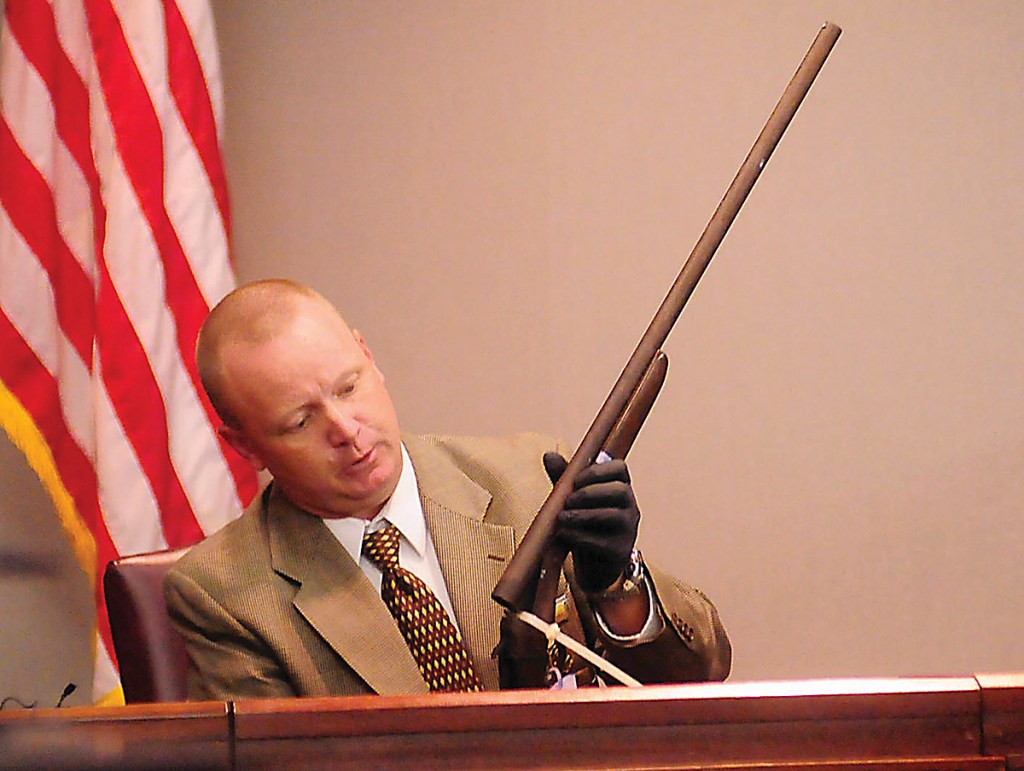Autopsies described for 8 Ga. mobile home victims
Published 3:00 pm Thursday, October 17, 2013

- Glynn County Police Lt. Keith Stalvey shows the jury a shotgun taken from the trunk of the car Guy Heinze Jr. was driving when he returned home Aug. 29, 2009, to find his father and seven others dead in the trailer where lived with them, during Heinze's trial on Wednesday, Oct. 16, 2013, in Brunswick, Ga. Guy Heinze Jr. is charged with killing his father and seven other family members who shared a cramped mobile home just outside Brunswick. Heinze Jr. faces the death penalty if he's convicted of murder in the Aug. 29, 2009, slayings.
Eight victims clubbed to death inside a coastal Georgia mobile home years ago suffered more than 220 injuries total, mostly from repeated blows to the head that caused deep lacerations, skull fractures and internal bleeding around the brain, the medical examiner who conducted the autopsies told a jury Wednesday.
Dr. Edmund Donoghue testified that most of the victims were stuck with such tremendous force that pressure from the blows cracked the base of their skulls.
“You normally only see these kinds of injuries in automobile accidents or when people fall from buildings,” said Donoghue, a Savannah-based medical examiner for the Georgia Bureau of Investigation.
He took the witness stand Wednesday on the second day of the trial of 26-year-old Guy Heinze Jr., who is charged with killing his father and seven other family members who shared a cramped mobile home just outside Brunswick. Heinze faces the death penalty if he’s convicted of malice murder in the Aug. 29, 2009, slayings.
Donoghue walked jurors through each autopsy Wednesday, showing them dozens of photographs of the victims and their wounds. He said all died from blunt trauma to the skull and brain.
The suspect’s father, 45-year-old Guy Heinze Sr., had 22 external wounds — skin tears, scrapes and bruises — to his head, neck and shoulders plus multiple internal injuries. Rusty Toler Sr., 44, had more than 30 wounds including a deep laceration nearly 6 inches long that creased the top of his head.
His older son, 20-year-old Russell D. Toler Jr., had several teeth knocked out and was stabbed three times in addition to being bludgeoned. And his younger daughter, 15-year-old Michelle Toler, suffered 48 external injuries to her face, head and arms. She also had broken bones in her left hand.
The edler Toler’s two other children — Chrissy Toler, 22, and Michael Toler, 19 — suffered similar injuries. So did his sister, Brenda Gail Falagan, 49, and Joseph W. West, the 30-year-old boyfriend of Chrissy Toler. Her 3-year-old son, Byron Jimerson Jr., ended up the sole survivor. Prosecutors said he suffered severe brain damage and could not help them as a witness.
The medical examiner testified wounds to all eight victims appeared consistent, as if they were caused by the same weapon or similar ones. Donoghue said parallel marks on some victims indicated they were beaten with a long, thin object such as a nightstick.
He agreed with prosecutor John B. Johnson that the weapon could have been a shotgun barrel. That’s what police suspect was used to commit the slayings, though no murder weapon was found. He also conceded to Heinze’s defense attorney, Newell Hamilton Jr., that the weapon could have been something else.
“The barrel of gun certainly fits the pattern,” Donoghue said.
“But so does any pipe,” Hamilton replied.
On Wednesday, jurors heard the frantic 911 call in which Heinze said he had come home from a late night out and discovered the bodies. On the call he cried: “My whole family is dead! It looks like they’ve been beaten to death.”
Prosecutors have told the jury it’s significant that Heinze knew immediately how the victims had been killed. Glynn County police Lt. Keith Stalvey, who was the first officer on the scene, testified that the victims’ head injuries were so grave that he at first thought they had been shot.
Heinze’s defense attorneys say police rushed to build a case against Heinze and ignored other possible suspects. Defense attorney Hamilton also told jurors that police were ill-equipped to deal with such an overwhelming crime scene, with blood spattered on the floors and walls of a home already covered with trash and discarded clothing.
Hamilton pressed Stalvey on why he persisted in questioning Heinze at the scene when he was shaken after seeing the bodies and was under the influence of drugs. Heinze told police he had been smoking marijuana. Drug tests later showed crack cocaine and a prescription painkiller in his system.
“You have walked into the crime scene and seen blood covering the walls,” Hamilton said to the police officer. “You wouldn’t assume he was traumatized by that?”
“He may have been traumatized, but I was at a murder scene,” replied Stalvey, who said Heinze was not a suspect at the time and wouldn’t have been questioned if he had been because he was intoxicated. “And I was trying to the best I could and find out who did it.”
For more on this story and other local news, subscribe to The Valdosta Daily Times e-Edition, or our print edition.



